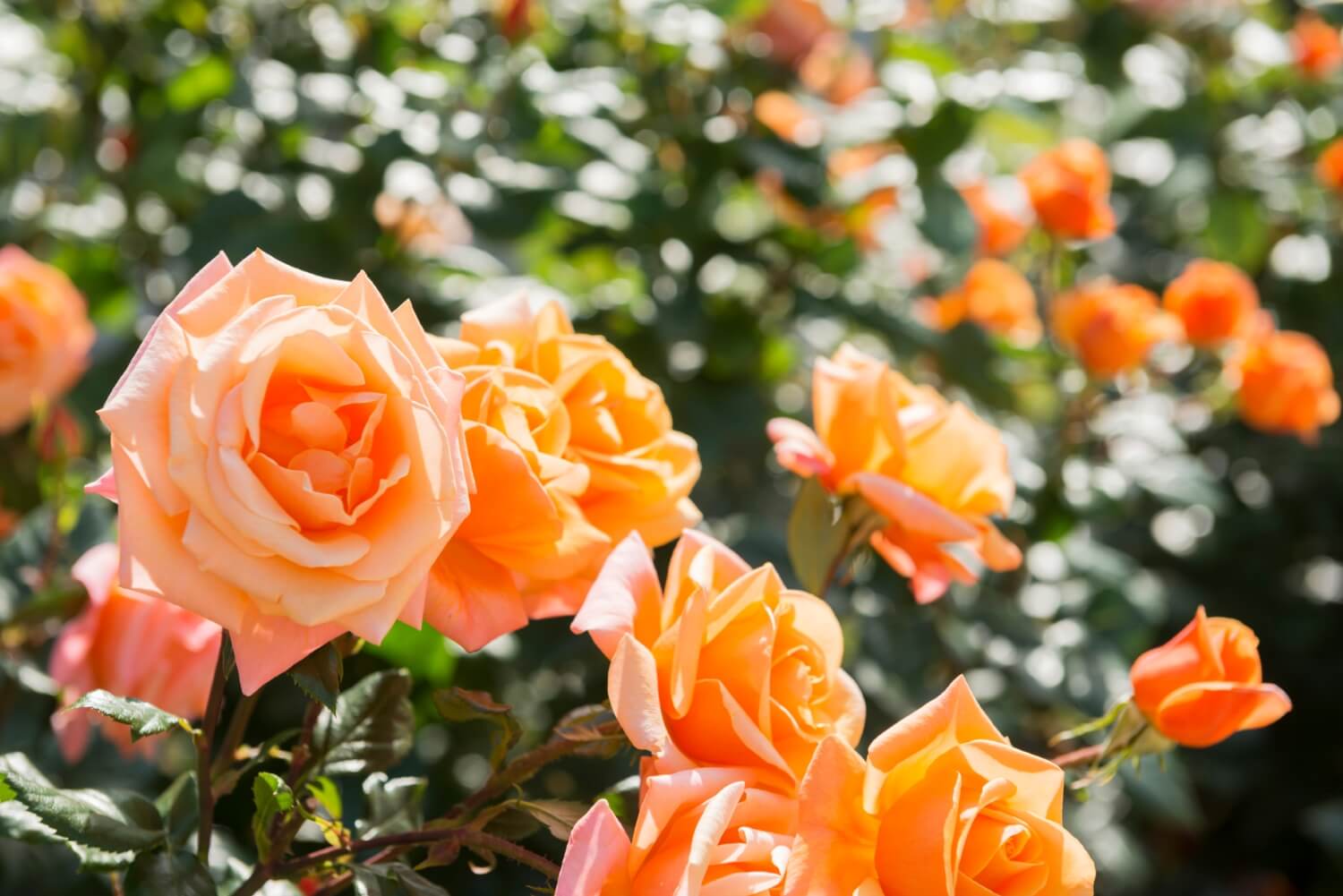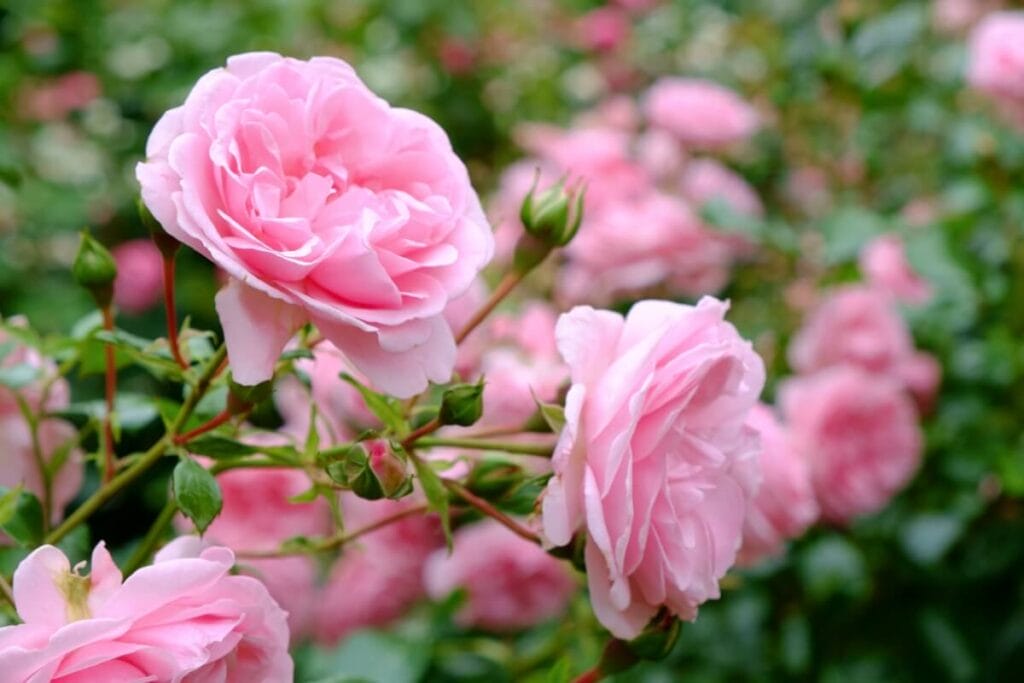Eco-Friendly Rose Gardening Tips
Roses’ beautiful blooms and varied growth forms make them some of the most popular garden flowers. However, these plants sometimes get a bad rap for being hard on the environment. Toxic pesticides, fungicides, and high water consumption are some of the top reasons roses aren’t always eco-friendly. Fortunately, there are more sustainable ways to grow these popular flowers! I’ll share eight tips to help grow environmentally friendly roses.

1. Mulch to Conserve Moisture
If you live in a drought-prone area, water conservation should be at the top of your mind. Along with practicing sustainable watering practices, you can also mulch your rose plants to conserve moisture for a more eco-friendly approach to rose gardening.
Mulch helps trap moisture in the ground and prevent it from evaporating. Therefore, you won’t have to water as often. Not only will this save water, but it will also prevent plants from becoming drought-stressed.
2. Water at the Base of the Plants
There are many ways you can water rose plants, from sprinkles to hoses to drip tape. Choosing a method that puts water directly into the ground is the most sustainable method for two reasons.
When you water the base of the plants, the moisture percolates into the ground, limiting evaporation. This means it limits wasted water. Overhead watering via sprinkles or hoses sends moisture into the air, which increases evaporation and decreases efficiency.
Watering the base of the plant also keeps the rose leaves dry. Dry leaves are less likely to develop fungal diseases such as powdery mildew, rose rust, black spot, and downy mildew. And when roses are disease-free, you don’t have to apply fungicides!
3. Plant a Diverse Garden to Encourage Natural Enemies

One way to combat common rose pests like aphids, Japanese beetles, and thrips is to create an environment where beneficial insects thrive. While some insects are pests, others work to control the bad bugs. Keeping these good bugs in your garden will help keep pests in check.
Planting a diverse garden will attract and keep natural predators like ladybugs, assassin bugs, green lacewings, and tachinid flies. Although the larvae of these critters feed on pests, many of the adult forms eat nectar and pollen. For example, green lacewing larvae are voracious aphid predators, but the adults eat nectar, pollen, and aphid honeydew.
When the adults have food to eat, they’re more likely to remain in your garden. And that means there’s a greater chance they’ll lay their eggs in pests or produce larvae that devour unwelcome critters.
You can also purchase natural enemies like parasitic wasps and ladybugs to release into your garden. As long as they have access to the proper food sources, they’re likely to stick around.
4. Choose Organic Pest Control Methods
If pests get out of control in your garden and natural predators aren’t keeping them down, you may need to turn to pesticides to control them. If you want to keep things as eco-friendly as possible, choose organic pesticides over synthetic options.
Organic pesticides are made from naturally occurring materials like bacteria and plant extracts. They require less fossil fuels to produce than synthetic pesticides, and many of them are less harmful to the surrounding environment.
With that said, incorrectly applying any type of pesticide (yes, even organic ones) can harm the environment. Make sure you always follow product application instructions and never overapply products.
5. Avoid Broad Spectrum Insecticides and Apply Carefully
When possible, opt for an insecticide that specifically targets the pest at hand. This will help protect non-target beneficial insects like bees, butterflies, ladybugs, and parasitic wasps.
Along with choosing the most targeted product, carefully apply all pesticides. Spraying during the morning and evening will help protect pollinators. Try to spray during a calm day to prevent pesticide drift.
6. Grow Disease Resistant Varieties

Another way to limit the use of fungicides is to plant disease-resistant rose cultivars. If you know that your rose plants have succumbed to a certain disease in the past, look for a variety that’s better at fighting off the problematic pathogen.
While resistant varieties aren’t necessarily immune to diseases, they are less likely to become infected. And that means you won’t have to spray fungicides to keep your plants healthy.
7. Increase Airflow to Prevent Disease
If you want to grow healthy roses without using fungicides, pay close attention to rose plant spacing and pruning. Many fungal diseases are more likely to occur with poor airflow, so allowing adequate space between leaves helps prevent the onset and spread of disease.
Since rose varieties grow to various shapes and sizes, research your unique cultivar before planting. Ensure the plant will have room to grow without encroaching on other plants.
When it comes to pruning, remove any dead and diseased branches in the early spring. You can also remove any crossing canes and prune the remaining canes so they’re one to two feet long. This will encourage the plants to produce healthy new growth.
8. Choose Organic Fertilizers
There’s no arguing that roses require nutrients to thrive. If you forgo fertilizing your rose plants, you’ll notice unwelcome symptoms like slowed growth, yellowing foliage, a lack of flowers, and poor cold tolerance.
However, when it comes time to fertilize your rose, you have a lot of options! If you’re looking for a sustainable option, choose organic fertilizers. These fertilizers are made from naturally occurring materials like rock dust, feathers, and manure. On the other hand, synthetic fertilizers are produced in a lab with the help of fossil fuels.
Even if you choose an organic fertilizer, look for a product designed for flowering shrubs. Two suitable products are Down to Earth Rose and Flower Mix and Burpee Organic Rose and Bloom. No matter which fertilizer you choose, follow product instructions and don’t overapply. Adding too much fertilizer can result in runoff and harm the surrounding environment.
Wrapping Up
Fortunately, growing beautiful roses and utilizing eco-friendly methods don’t have to be mutually exclusive. Implement the above tips to grow beautiful roses in a more sustainable manner.
Briana holds a B.S. in Plant Sciences from Penn State University. She manages a small market garden where she grows vegetables and herbs. She also enjoys growing flowers and houseplants at home.

